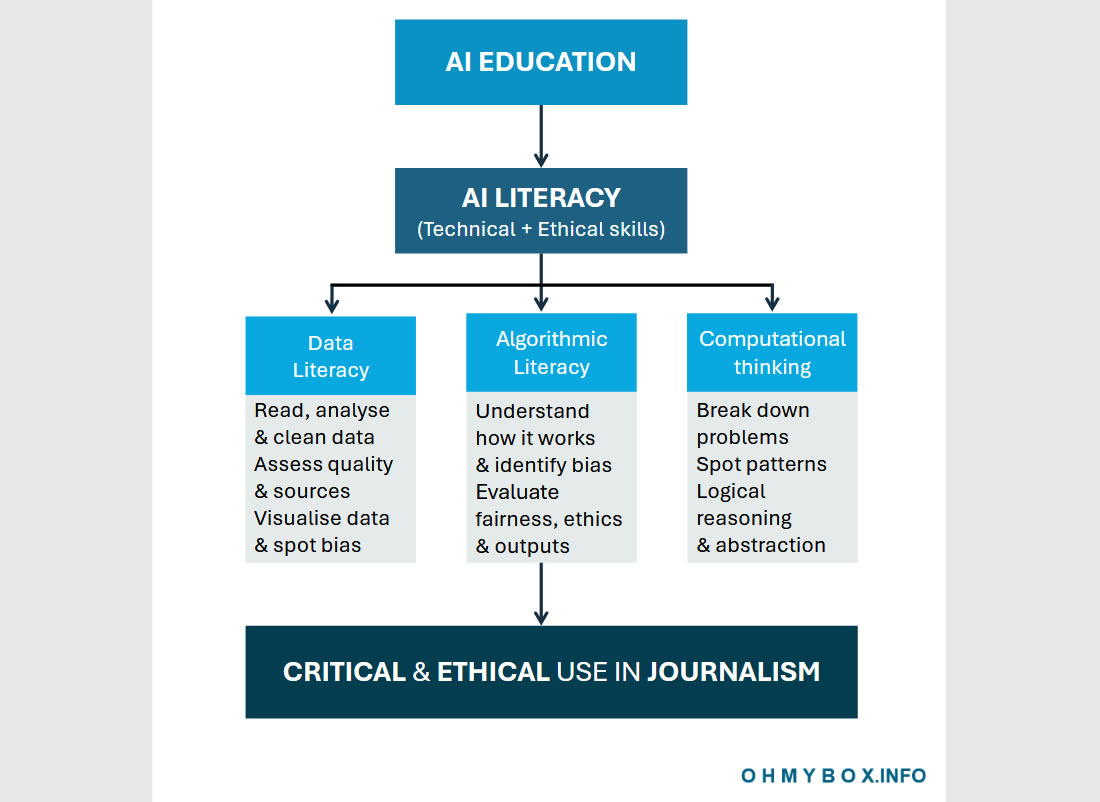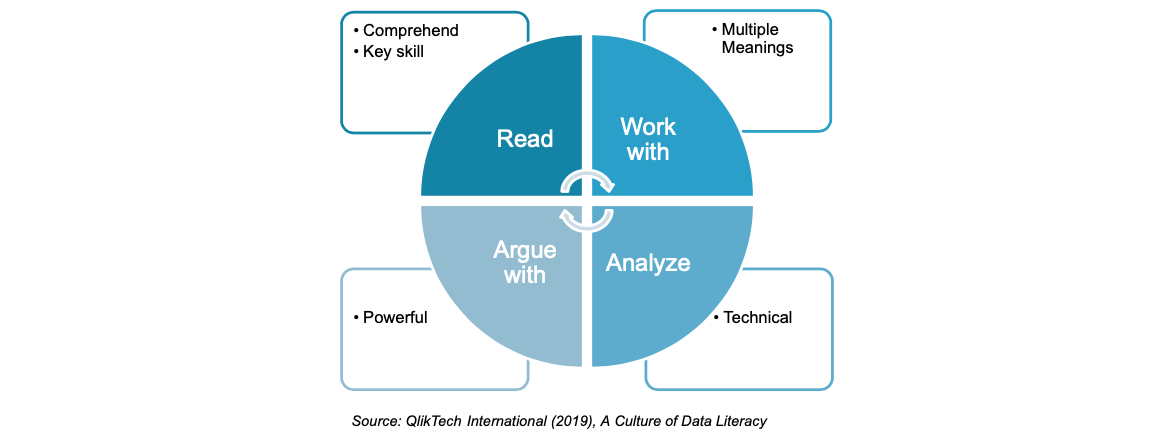Data literacy, algorithmic literacy, and computational thinking are inseparable concepts. Together, these skills form an essential foundation for critically and ethically understanding and using artificial intelligence in journalism.
 AI literacy refers to the acquisition of technical and ethical skills necessary to understand, use, and interact responsibly with artificial intelligence technologies. It includes mastering the fundamental concepts of AI, how it works, and its applications in journalism while highlighting the social, ethical, and professional issues associated with it. AI education enables journalists to use technological tools critically, considering the ethical, societal, and professional implications. It is based on a reflective approach that considers the challenges posed by these technologies, especially regarding transparency, bias, and privacy. More than just technical understanding, AI literacy encourages viewing these technologies as tools to enhance human capabilities while preserving the core values of journalism.
AI literacy refers to the acquisition of technical and ethical skills necessary to understand, use, and interact responsibly with artificial intelligence technologies. It includes mastering the fundamental concepts of AI, how it works, and its applications in journalism while highlighting the social, ethical, and professional issues associated with it. AI education enables journalists to use technological tools critically, considering the ethical, societal, and professional implications. It is based on a reflective approach that considers the challenges posed by these technologies, especially regarding transparency, bias, and privacy. More than just technical understanding, AI literacy encourages viewing these technologies as tools to enhance human capabilities while preserving the core values of journalism.
AI literacy in journalism
| Component | Description | Application |
|---|---|---|
| Technical skills | Understanding the fundamental concepts of AI, how it works, the main algorithms, and practical applications. | Mastering the use of AI tools, such as natural language processing systems and data analysis tools. |
| Practical skills | Applying technical concepts in real-world contexts, understanding how to integrate AI into the journalistic process, and developing practical skills (with generative AI, ie). | Using AI to generate reports, fact-check, or create automated content while being mindful of their limitations. |
| Ethical skills | Understanding the ethical issues related to AI, such as privacy, data protection, and algorithmic biases. | Evaluating the impact of AI on news information, understanding biases in data collection, and questioning algorithm transparency. |
| Critical thinking | Adopting a reflective approach towards technology, understanding its social and professional implications. | Questioning the results produced by AI, detecting biases, and ensuring that tools are used ethically in journalism. |
| Collaboration with technical experts | Developing skills to work with ML engineers and data scientists. | Collaborating with specialists to design AI tools tailored to the specific needs of journalism while remaining conscious of ethical implications. |
Data literacy is one of the pillars of AI education. It is based on the ability to read, understand, and analyse the data used in AI systems. This skill allows journalists to question the quality and biases of data, which is critical for evaluating the reliability of AI tools and their applications in journalism. It enables the detection of potential errors and understanding of the stereotypes perpetuated by generative AI systems.
Data literacy in journalism
| Component | Description | Application |
|---|---|---|
| Understanding data | The ability to read and understand data, including its source, format, and context. | Analysing data sets to extract relevant and accurate information while considering their context and origin. |
| Evaluating data quality | Evaluating the quality, reliability, and validity of data used, particularly in AI systems. | Critiquing the quality of data used in articles, identifying biases or errors in datasets that might affect the objectivity of information. |
| Data cleaning | Removing errors, missing values, or inconsistencies in data sets. | Preparing data for analysis by cleaning and structuring information to ensure accuracy and reliability. |
| Data visualisation | Using charts and visualisations to interpret and present data clearly and understandably. | Creating graphs, tables, or infographics to communicate complex data and assist in informed decision-making effectively. |
| Respecting data confidentiality | Understanding and applying data confidentiality and protection standards when handling sensitive information. | Ensuring compliance with data privacy regulations when reporting personal or sensitive data. |
| Identifying biases in data | Recognising biases present in data sets and understanding how they may influence outcomes. | Analysing biases in data used by AI systems and understanding their impact on the representation of information, particularly regarding diversity and inclusivity. |

Algorithmic literacy, on the other hand, complements data literacy by enabling the understanding of the underlying processes governing AI systems. It allows one to grasp the logic of algorithms, how they function, and their social and ethical impacts. It is essential for identifying risks associated with automated decisions, such as algorithmic biases, discrimination, or the black-box effects. A solid knowledge of algorithms allows journalists to better understand the tools they use, to make informed decisions in their professional routines and to make these technologies the subject of their investigations.
Algorithmic literacy in journalism
| Component | Description | Application |
|---|---|---|
| Understanding algorithms | The ability to understand how algorithms work, their basic logic, and the processes they follow to process information. | Analysing the algorithms used in AI tools to evaluate their transparency, decision logic, and impact on media outcomes. |
| Identifying algorithmic biases | Recognising that algorithms can be influenced by human or structural biases that affect outcomes. | Understanding how algorithmic biases can influence certain communities or information representation. |
| Considering the black box | Understanding that some algorithms, particularly complex AI models, are black boxes, making their decisions difficult to explain or understand. | Questioning the transparency of AI tools used and seeking explanations for decisions made by algorithms to ensure accountability. |
| Ethics of algorithms | Understanding the ethical implications of using algorithms, particularly regarding fairness, discrimination, and social impact. | Developing a critical reflection on the algorithms used in journalism and their ability to uphold journalistic values. |
| Analysing algorithmic results | Evaluating the results produced by algorithms and understanding the factors that influence the outputs of these systems. | Critiquing the results generated by algorithmic tools, identifying anomalies or issues that could affect the integrity of the information. |
Computational thinking connects data literacy and algorithmic literacy by providing a conceptual framework for approaching problems logically and structurally. It allows the decomposition of complex tasks, the modelling of processes, and reasoning through algorithmic logic. In journalism, it helps to engage more critically with technologies while promoting effective collaboration with technical experts. It also enables a better understanding of the limits of AI systems and their thoughtful use, taking into account ethical and practical considerations.
Applications of computational thinking in journalism
| Component | Description | Application |
|---|---|---|
| Logic | Structured reasoning based on precise rules. | Making logical decisions regarding using AI tools in journalistic practices. |
| Evaluation | Judging the validity and relevance of information or proposed solutions. | Evaluating the reliability of data, algorithms, and AI-generated results. |
| Algorithm | A set of precise instructions to solve a problem. | Designing or understanding the underlying processes of AI systems used in journalism. |
| Patterns | Identifying recurring patterns or structures in data. | Recognising patterns in algorithmic behaviour and search results. |
| Decomposition | Breaking down a complex problem into smaller, simpler parts. | Simplifying the analysis of complex data and breaking tasks into practical steps for journalists. |
| Abstraction | Ignoring irrelevant details to focus on the essential. | Focusing on the most relevant aspects of data or algorithmic processes for their application in journalism. |
Data literacy, algorithmic literacy, and computational thinking are integral parts of AI literacy, essential for responsible journalistic practice in a world increasingly shaped by technology. AI literacy goes beyond the mere technical mastery of tools: it includes understanding data, algorithms, and the ethical and social principles that guide their use. It enables journalists not only to understand how AI systems work but also to question their implications in producing and disseminating information. Also, AI literacy offers journalists a critical and reflective framework for using these technologies while preserving the core values of journalism.




